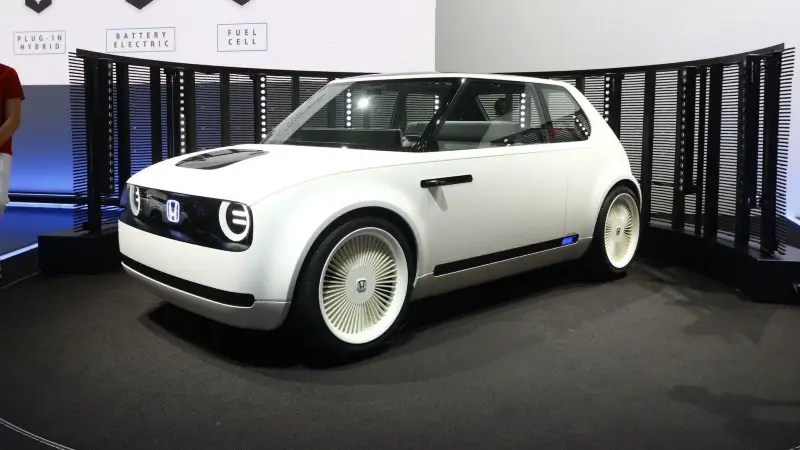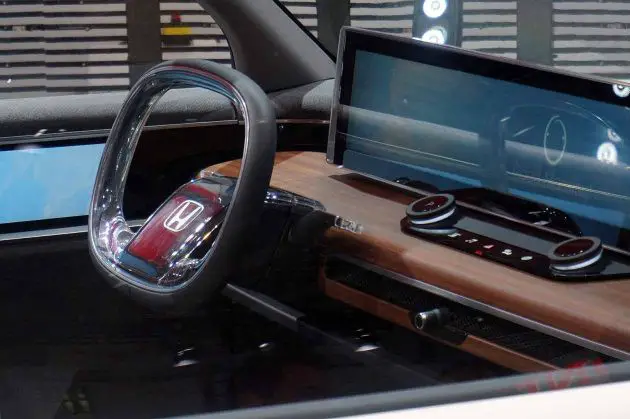Honda Urban EV
The Urban EV will be more practical than the prototype, however, with seating for five instead of four and more conventional-looking…


The Urban EV will be more practical than the prototype, however, with seating for five instead of four and more conventional-looking switch gear inside. The rear-hinged coach doors from the prototype are being retained, though.
The Urban EV is one of 12 cars in contention for the 2019. Built on a new electric car platform, the Renault Zoe rival is shorter than the Honda Jazz, but it’s tall, with a wide windscreen and narrow pillars to aid visibility.
Energy will be supplied by a high-density, lightweight battery pack, which will be able to transfer electricity both to and from the vehicle. This could allow owners to buy electricity from the grid when it’s cheap and sell it back when demand is high and the car is already fully charged — a concept already explored by Nissan with its Leaf. Alternatively, that energy could be used to power your home.
The Urban EV is expected to have an official range of around 155 miles from its single electric motor. That would give it considerably less range than most mainstream electric cars, but likely enough for city-based buyers to use on a daily basis.
On the outside, the Urban EV is the first model to have a Honda emblem that’s back lit in blue. It also has a panel between the headlights that can be used to display interactive messages, including advice for other drivers or charging status updates.
Although the Urban EV’s interior is likely to be toned down from the concept car’s, it’s still likely to have a ‘floating’ dashboard that houses the steering column, a set of simple control buttons and a panoramic screen that extends past the end of the dashboard and onto the front door panels to act as digital alternatives to wing mirrors. The electric Audi E-tron will become the first production car to offer cameras in place of mirrors.
Although the Urban EV is a small car, it’s being positioned as a premium model, so it won’t be cheap to buy. Prices expected to start at around £28,000, pitching the Urban EV in below the BMW i3, which starts at £34,445, but above the £27,290 Nissan Leaf.
The Honda Urban EV is set to take on the likes of the Mini EV and BMW i3. With posh cars like that in its sights you can expect the Honda EV to carry a premium price tag of somewhere in the region of £30,000.
Honda Urban EV specs
If Honda hopes to pull buyers away from BMWs and Minis then it’ll have to offer similar kerb appeal. Thankfully, kerb appeal is something the cheeky concept car has in spades and you can expect a lot of its charm to be carried over to the production model.
As a result, expect it to get the same bluff nose with retro circular headlights lit up by rings of LEDs.
Side on, the skinny pillars of the concept car will be replaced by a sturdier structure in the production model, but even more obvious than this is the addition of rear doors.They are said to hinge from the rear — an eye-catching touch that will also give your passengers better access to the back seat.
Even the rear of the Honda will have retro charm with round tail lights — featuring the same ring elements as up front — and strips of LEDs in the centre of the circle that light up when the car brakes.

The interior of Honda Urban EV will drop conventional wing mirrors for rear-facing cameras. Already seen on the Audi e-tron, they give you a wider view, while their smaller size makes them more aerodynamic.
The latter is an important to help the Honda Urban EV get a decent range out of its batteries. It won’t travel as far as expensive EVs like the Audi or Tesla Model S, but you can expect 150 miles from a single charge. A 0–62 mph time of around 10 seconds is possible and would be quick enough to hit the Honda’s sporty-city-car brief.
It has no gears to worry about — accelerating will be simply a matter of pressing on the pedal.




